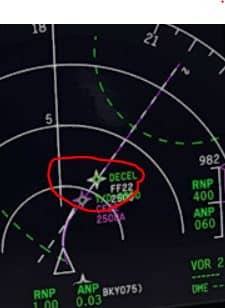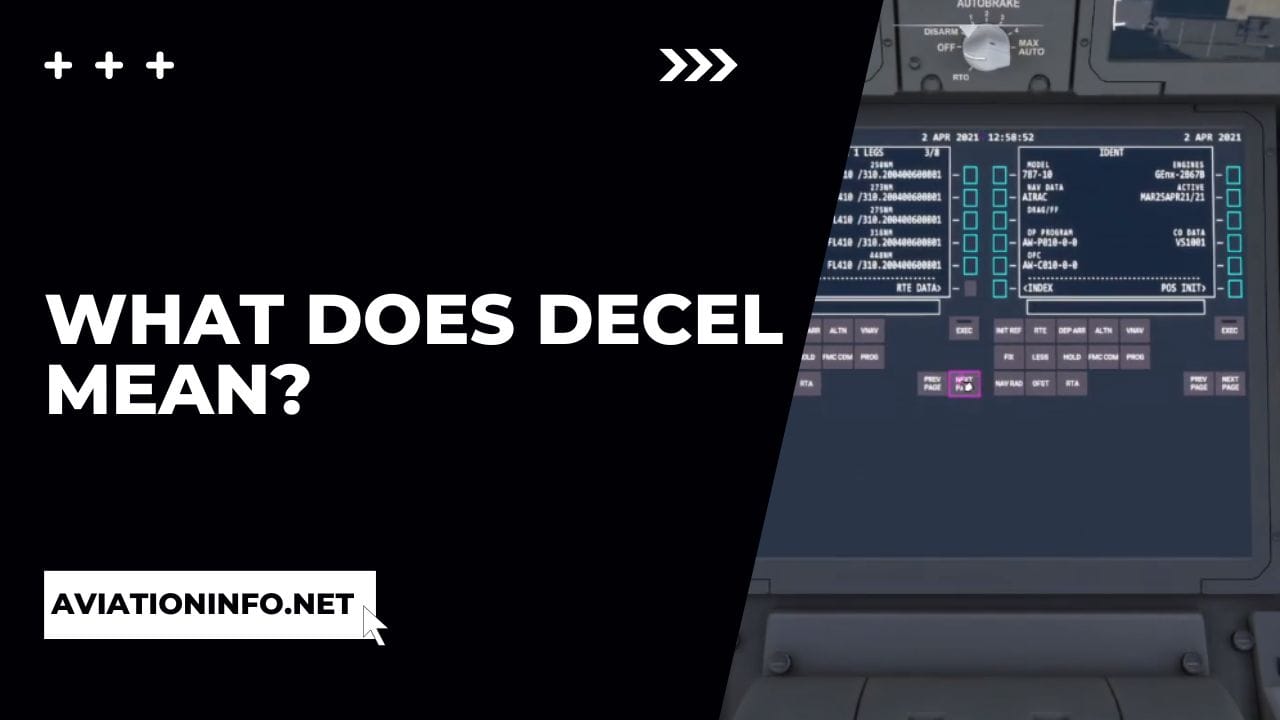During the descent and approach phase of flight, there is a transition and shift in relation to the speed and altitude of the aircraft.
During the approach and landing phases, there is a need for the aircraft to decelerate in terms of airspeed in order to enter the necessary landing configuration – this includes the landing flap setting, speed brake/spoilers to ARM and the landing gear selected to the DOWN position.
What Does DECEL Mean?
On the ND (Navigation Display) of modern commercial aircraft, there is a “waypoint” of such generated via the FMS flight plan calculations in relation to speed and altitude profiles.
This waypoint is labelled in green and is marked as “DECEL”. It is the point in which airspeed should be decreased for the calculated approach and landing speeds.
The DECEL point allows for a sufficient margin between the aircraft reaching its VAPP from its current airspeed.
From the DECEL point, the aircraft’s airspeed should be reduced to VAPP – the final approach speed of the aircraft in which flaps and landing gear are in landing configuration.
The exact distance from landing that the DECEL point is generated will depend on factors such as ATC instructions and the selected Standard Terminal Arrival (STAR).

As can be seen in the diagram above, the “DECEL” waypoint marker indicates the point at which the aircraft should be decelerated to the required approach speeds.
The Flight plan (FPL) page of the FMS will further outline the DECEL point for the aircraft along with the succeeding waypoints corresponding speed and altitude constraints.
Although the DECEL provides guidance to the flight crew in regards to preparing the aircraft for landing configuration, the actual deceleration profile of the aircraft may be a deviation of this – ATC may issue instructions for reducing speed.
The DECEL indication is based on correct descent planning being planned and executed.
The DECEL system was introduced in modern commercial aircraft design to enhance energy management in relation to descent and approach planning while also assisting in easing the flight crew workload.
On the Flight Mode Annunciator (FMA) of the aircraft, “DECEL” will be displayed at the calculated DECEL waypoint.
Open Descent vs Managed Descent
Predominantly an Airbus associated terminology, open descent and managed descent are the two modes available as part of the speed and altitude systems of modern autopilot systems.
They allow for different modes of planning as to regard the speed and altitude management of the aircraft.
As the name suggests, managed descent is an automated mode in which the aircraft’s auto thrust system follows the Flight Plan (FPL) page of the FMS in relation to speed and altitude constraint profile for each specific waypoint.
This includes the DECEL point in which managed mode would adjust thrust settings to DECEL power.
Managed descent can be selected on Boeing aircraft via the Vertical Navigation (VNAV) switch on the Mode Control Panel (MCP). On Airbus aircraft, it is activated by pushing the altitude target knob inwards on the Flight Control Unit (FCU).
Open descent (OP DES) differs in that it involves the aircraft descending to the set target altitude without following the set altitude and speed constraints on the FMS.
In open descent mode, the flight crew manually control the Vertical Speed (V/S) of the aircraft. This can usually be adjusted in increments of +/- 100 feet a minute.
Open descent mode is selected on Boeing aircraft via engaging the V/S mode and by pulling outwards on the V/S and altitude knob on Airbus aircraft.
Open descent mode is used when it is required for flight crew to manually adjust the descent and deceleration profile of the aircraft.
This can be for several reasons, however it is normally to follow ATC instructions or if there are modifications to the original descent and arrival routing (an aircraft may get a shortcut/DIRECT TO instruction from ATC).
In open descent mode, flight crew workload levels are susceptible to increasing as manual inputs are required to meet the DECEL waypoint deceleration profile.
Read More:
What is Contact Flight? | Aviation Glossary

After visiting more than 60 countries, I have probably been on every type of plane there is and visited countless airports. I did my very first international solo trip to South Africa at the age of only 16 and haven’t really stopped traveling since.
Despite the adventurous travel itch, I do have a nerdy side as well – which is satisfied by writing about all things aviation “too boring” for my regular travel blog.

